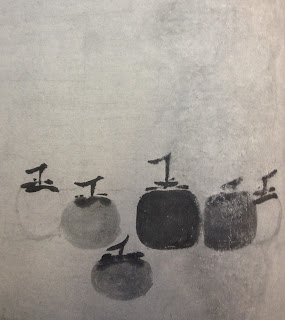Zen aesthetics
cannot be separated from its ethics, whose goal is satori through
self-awareness, and these seven principles are tools for such awareness through
aesthetical action. The action has to be asymmetrical, for in asymmetry there
is incompleteness and therefore movement and change, giving a living reference
for an experience that is basically looking for a general sense of
imperturbability inside motion. Asymmetry is complexity and is to be balanced
by a principle of simplicity both in actions and means. Both principles can be synthesized
without much effort in the quick movements of calligraphy, or in the calm
representations of the artificially combed landscape of a stone garden, as long
as we maintain the third principle as the aesthetical attractor or engine for
our art: austere sublimity. “Sublime” should be understood as being bony and
not sensuous, as Hisamatsu proposes, or in other words, sublime is the
non-human dimension of the experience, the overwhelming universality of
individual life sailing its streams of time. Japanese haikai represent this
sense of universality in their first verse. “Austere” modifies “sublime”
redirecting its possible stormy connotations into the realm of sparse objects
and relations, certainly what characterizes better Zen aesthetics in relation
to other artistic proposals. On the other hand, the principle of naturalness
focuses the artistic action outside the social milieu and the use of art for other purposes than the mystical experience. Here there is an obvious
contradiction, for the Zen artist tries deliberately to be natural and not
artificial, furthermore, assumes the seven principles, which are far from being
natural guidelines to action. The contradiction is somewhat minimized through
the principle of profound subtlety and the call for an egoless art, after all,
Zen Buddhism is the Japanese development of the Mahayana Chang Buddhism, a
non-dual metaphysical proposal, but ego is precisely a very natural phenomenon
of animal life, and any reduction of the ego is a reduction of vitality. In
this sense, Zen crushes violently with the Nietzschean aesthetics of vitalism
which pervaded the avant-garde and still drives today the art markets responsible
for our ideas of what art should be. The principle of freedom from attachment
widens the gap with our present vitalism-capitalism even more, making of Zen
art a marginal discourse fit only for the selected temples of the critics and
other chosen priests. Finally, the principle of tranquility becomes too often
in our society a mere death wish, or the desire of a massage after a long day
at the office, and not a seasoned ataraxia (imperturbability) that assigns its pondered
value to the fleeting phantoms of our social life. If we do not stress our
minds our encephalograms become flat and our heart shrinks into empty
desperation.
An
alternative to Zen aesthetics was developed by the New York abstract
expressionism in music and painting. Though some of the roots of such
aesthetics is Zen itself (as is the case of John Cage) or a general interest in
Japanese culture (not exempt of remorse) after WW2, there is another root for stillness,
like the one we observe in Feldman and Rothko, that is more related to desert
landscapes of the mind provided by life in modern cities, places where anxiety
and compulsion look for a cure in any stillness dance. It found its room in the
corporate hallways of Manhattan, where the religion of genius still gives an
alibi for art merchandizing, translating the austere sublimity of simple
still-life composing into the sublime emptiness of money. Back in 1984,
precisely while I was studying with Feldman, I was trying to find my way
between a meditative need for meaning in the peak of the cold war, a
mathematical drive for clarity, and the wild hormones of a young vitalism which
had me running from one thing to another. I found myself in the hands of the
crippled symmetry of modern art, building ultra-civilized sound landscapes which
opened my mind to blue distances of nostalgia but shut the door for the
development of any aesthetics of life. Nonetheless, after more than 30 years
thinking about the subject and practicing it in my music and painting, I still
think that there is an element of Zen
aesthetics (and any aesthetics of the universal law in general) that makes
sense for any vitalist art: the uncompromised drive for clarity and simplicity
that life needs in its symbolical complexification processes.

Comments
Post a Comment
Please write here your comments